chapter 4.1
Objectives
- Introduce the elements of geometry
- Scalars
- Vectors
- Points
- Develop mathematical operations among them in a coordinate-free manner
- Define basic primitives
- Line segments
- Polygons
Basic Elements
- Geometry is the study of the relationships
among objects in an n-dimensional space
- In computer graphics, we are interested in objects that exist in three dimensions
- Want a minimum set of primitives from which we can build more sophisticated objects
- We will need three basic elements
- Scalars
- Vectors
- Points
Coordinate-Free Geometry
- When we learned simple geometry, most of
us started with a Cartesian approach
- Points were at locations in space p=(x,y,z)
- We derived results by algebraic manipulations involving these coordinates
- This approach was nonphysical
- Physically, points exist regardless of the location of an arbitrary coordinate system
- Most geometric results are independent of the coordinate system
- Euclidean geometry: two triangles are identical if two corresponding sides and the angle between them are identical
Scalars
- Need three basic elements in geometry
- Scalars, Vectors, Points
- Scalars can be defined as members of sets which can be combined by two operations (addition and multiplication) obeying some fundamental axioms (associativity, commutivity, inverses)
- Examples include the real and complex number systems under the ordinary rules with which we are familiar
- Scalars alone have no geometric properties
- Physical definition: a vector is a
quantity with two attributes
- Direction
- Magnitude
- Examples include
- Force
- Velocity
- Directed line segments
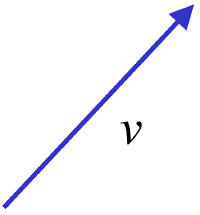
- Most important example for graphics
- Can map to other types
Vector Operations
- Every vector has an inverse
- Same magnitude but points in opposite direction
- Every vector can be multiplied by a scalar
- There is a zero vector
- Zero magnitude, undefined orientation
- The sum of any two vectors is a vector

- Mathematical system for manipulating vectors
- Operations
- Scalar-vector multiplication u = av
- Vector-vector addition: v = u + w
- Expressions such as
- v = u + 2w - 3r
- make sense in a vector space
Vectors Lack Position
- These vectors are identical
- Same direction and magnitude

- Vector spaces insufficient for geometry
- Need points
- Need points
Points
- Location in space
- Operations allowed between points and
vectors
- Point-point subtraction yields a vector
- Equivalent to point-vector addition

- Point + a vector space
- Operations
- Vector-vector addition
- Scalar-vector multiplication
- Point-vector addition
- Scalar-scalar operations
- For any point define
- 1 * P = P
- 0 * P = 0 (zero vector)
- Consider all points of the form
- P(a)=P0 + a(d)
- Set of all points that pass through P0 in the direction of the vector d

Parametric Form
- This form is known as the
parametric form of the line
- More robust and general than other forms
- Extends to curves and surfaces
- Two-dimensional forms
- Explicit: y = mx + h
- Implicit: ax + by + c =0
- Parametric (a in [0,1]):
- x(a) = (1-a)x0 + ax1
- y(a) = (1-a)y0 + ay1
Rays and Line Segments
- If a >= 0, then P(a) is
the ray leaving P0 in the direction d (as shown above)
If we use two points to define v, then
P(a) = Q + a(R - Q) = Q + av = (1 - a)Q + aR
For 0<=a<=1 we get all the points on the line segment joining R and Q
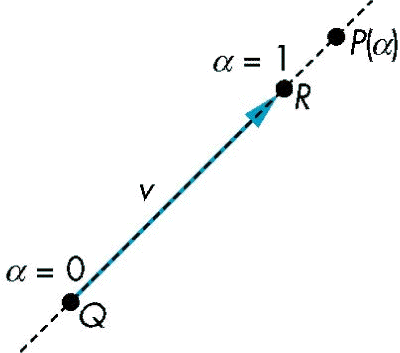
Convexity
- An object is convex iff for any two points in the object all points on the line segment between these points are also in the object
Affine Sums
- Consider the sum (affine addition with points Pi and scalars
ai - simple extension of adding 2 points as in ray discussion
above)
- P = a1P1 + a2P2 + ... + anPn
- Can show by induction
that this sum makes sense iff
- a1+ a 2+ ... an= 1
- in which case we have the affine sum of the points P1, P2, & .. Pn
- If, in addition, ai>=0, we have the convex hull of P1, P2, & .. Pn
Convex Hull
- Smallest convex object containing P1, P2, ..., Pn
- Formed by shrink wrapping
points
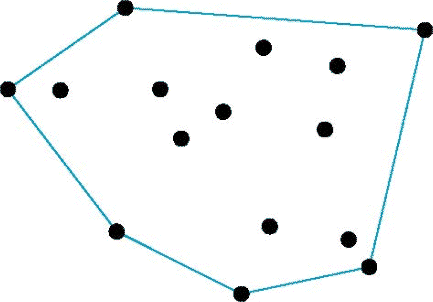
Curves and Surfaces
- Curves are one parameter entities of the form P(a) where the function is nonlinear
- Surfaces are formed from
two-parameter functions P(a, b)
- Linear functions give planes and polygons

Planes
- A plane can be determined by a point and two vectors or by three non-collinear points

Triangles

Normals
- Every plane has a vector, referred to as n, that is normal (perpendicular, orthogonal) to it
- From point-two vector form
P(a,b)=R+au+bv, we know we can use the cross
product to find n = u x v
and the equivalent form
of the plane as (P0 - P) x n = 0, where P0 and P are points on the plane.

Representation
Objectives
- Introduce concepts such as dimension and basis
- Introduce coordinate systems for representing vectors spaces and frames for representing affine spaces
- Discuss change of frames and bases
- Introduce homogeneous coordinates
Linear Independence
- A set of vectors v1, v2, ...,
vn is linearly independent if
- a1v1+a2v2+... anvn=0 iff a1= a2= ...an = 0
- If a set of vectors is linearly independent, we cannot represent one in terms of the others through any linear combination (scalar multiplication with vector addition) of the vectors
- If a set of vectors is
linearly dependent, as least one can be written in terms of
the others through a linear
combination
Dimension
- In a linear vector space, the maximum number of linearly independent vectors is fixed and is called the dimension of the space
- In an n-dimensional space, any set of n linearly independent vectors form a basis for the space
- Given a basis v1, v2, ..., vn, any vector v can be written as a linear combination of the basis vectors
v=a1v1+ a2v2 + ...+anvn
where the {ai} are unique
Representation
- Until now we have been able to work with geometric entities without using any frame of reference, such as a coordinate system
- Need a frame of reference to
relate points and objects to our physical world.
- For example, where is a point? Can't answer without a reference system
- World coordinates
- Camera coordinates
Coordinate Systems
- Consider a basis v1, v2, ..., vn
- A vector is written v=a1v1+ a2v2 + ... +anvn
- The list of scalars {a1, a2, ..., an} is the representation of v with respect to the given basis
- We can write the representation as a row or column matrix of scalars

Example
- v=2v1+3v2-4v3
- a=[2, 3, -4]T
- Note that this representation is with respect to a particular basis
- For example, in OpenGL we start by representing vectors using the world basis but later the system needs a representation in terms of the camera or eye basis
Coordinate Systems
- Which is correct?

- Both are because vectors have no fixed location
Frames
- A coordinate system is insufficient to represent points
- If we work in an affine space we can add a single point, the origin, to the basis vectors to form a frame

Representation in a Frame
- A frame in 3D space is determined by (P0, v1, v2 v3)
- Within this frame, every vector can be
written as
- v=a1v1+ a2v2 + ... +anvn
- Every point can be written as
- P = P0 + b1v1+ b2v2 + ...+ bnvn
Confusing Points and Vectors
- Consider the point and the vector
P = P0 + b1v1 + b2v2 + ... +bnvn
v=a1v1+ a2v2 + ...+ anvn
- They appear to have similar representations
p=[b1 b2 b3] v=[a1 a2 a3]
which confuses the point with the vector
- A vector has no position

- A vector has no position
A Single Representation
- If we define 0 *P = 0 and 1 *P =P then we
can write
v=a1v1+ a2v2 +a3v3 = [a1 a2 a3 0 ] [v1 v2 v3 P0] T
P = P0 + b1v1+ b2v2 +b3v3= [b1 b2 b3 1 ] [v1 v2 v3 P0] T
- Thus we obtain the four-dimensional
homogeneous coordinate representation
v = [a1 a2 a3 0 ] T
p = [b1 b2 b3 1 ] T
Homogeneous Coordinates
- The general form of four dimensional
homogeneous coordinates for points is
p=[x y z w] T
We return to a three dimensional point (for w! = 0) by
x x/w
x/w
y y/w
y/w
z z/w
z/w
If w = 0, the representation is that of a vector.
Note that homogeneous coordinates replace points in three dimensions by lines through the origin in four dimensions.
Homogeneous Coordinates and Computer Graphics
- Homogeneous coordinates are key to all
computer graphics systems
- All standard transformations (rotation, translation, scaling) can be implemented by matrix multiplications with 4 x 4 matrices
- Hardware pipeline works with 4 dimensional representations
- For orthographic viewing, we can maintain w = 0 for vectors and w = 1 for points
- For perspective we need a perspective division
Change of Coordinate
Systems (skip)
- Consider two representations of the same vector with respect to two different basis (a[v1, v2, v3] and b[u1, u2, u3]). The representations are

Representing second basis in terms of first
- Each of the basis vectors, u1,u2, u3, are vectors that can be represented in terms of the first basis
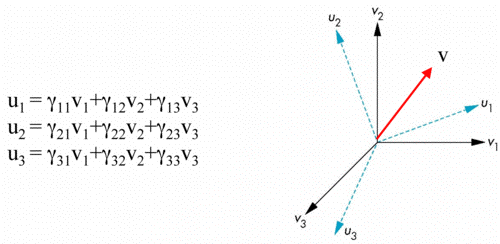
- The coefficients define a 3 x 3 matrix

- and the basis can be related by

where a =[u1, u2, u3]T and b = [v1, v2, v3]T
- see text for numerical examples
Change of Frames
- We can apply a similar process in homogeneous coordinates to the representations of both points and vectors
- Consider two frames
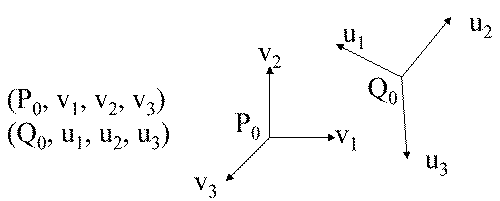
- Any point or vector can be represented in each
Representing One Frame in Terms of the Other
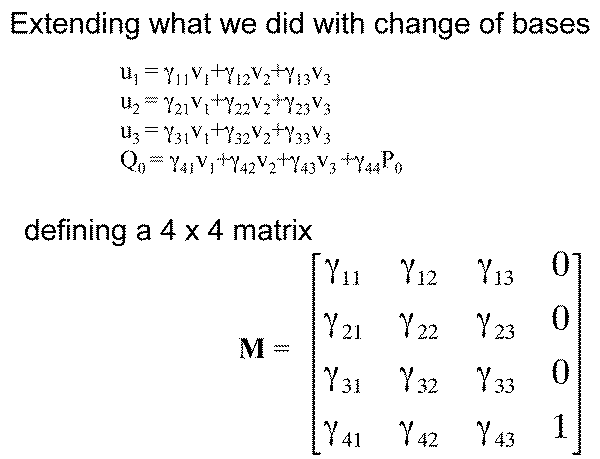
Working with Representations
- Within the two frames any
point or vector has a representation of the same form
a=[a1 a2 a3 a4 ] in the first frame
b=[b1 b2 b3 b4 ] in the second frame
where a4 = b4 = 1 for points and a4 = b4 = 0 for vectors and

- The matrix M is 4 x 4 and specifies an affine transformation in homogeneous coordinates
Affine Transformations
- Every linear transformation is equivalent to a change in frames
- Every affine transformation preserves lines
- However, an affine transformation has only 12 degrees of freedom because 4 of the elements in the matrix are fixed and are a subset of all possible 4 x 4 linear transformations
The World and Camera Frames
- When we work with representations, we work with n-tuples or arrays of scalars
- Changes in frame are then defined by 4 x 4 matrices
- In OpenGL, the base frame that we start with is the world frame
- Eventually we represent entities in the camera frame by changing the world representation using the model-view matrix
- Initially these frames are the same (M = I)
Moving the Camera
- If objects are on both sides of z = 0, we must move the camera frame
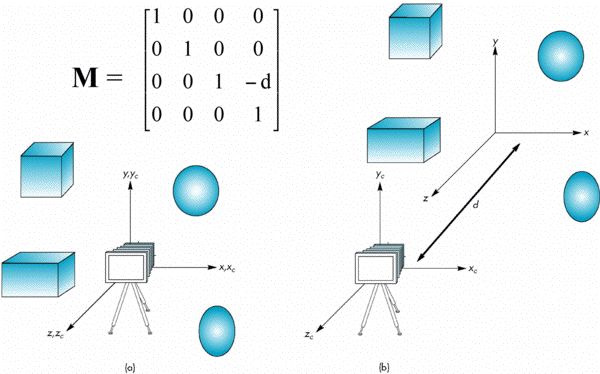
This actually results in moving the world frame relative to the camera frame. To the programmer it appears that all points in front of the camera are now visible, by moving them down the z axis by -d units. This is almost always easier than attempting to change vertex coordinates to place the objects in a visible position.
See the text for a numerical example. In OpenGL this is easily accomplished by translating all points by [0, 0, -d] - more later, or by moving the camera to [0, 0, d] - more later, both produce the same result.